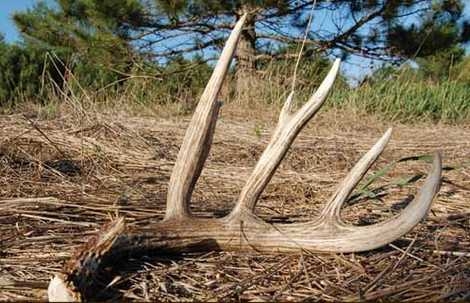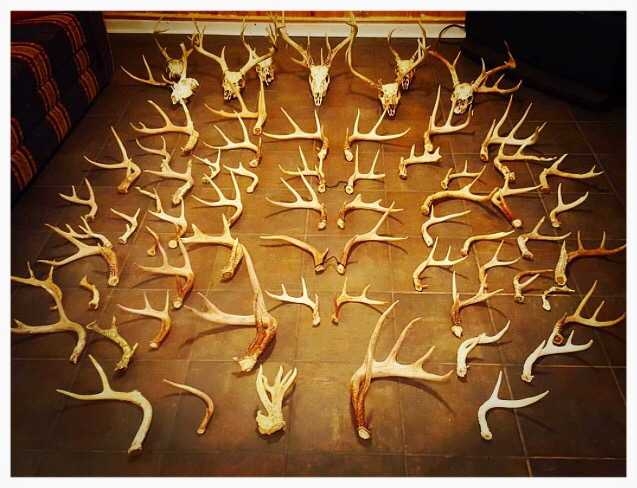
1 Photos
1. Be sure you aren't too early. Make sure the bucks in your area have dropped their headgear.
2. Your trail cam is your best friend. Move it to the places that the deer most frequent-food plots, feeders, fields etc...The pics will let you know when it's time to shed hunt.
3. Train your eyes. Take an old shed and continuously throw it in front of you(in the leaves) with your eyes closed. Once it lands, open and let your eyes find it. Same thing with mushroom hunting, once your eyes adjust you can spot sheds much easier.
4. Another shed hunting tip is to take along your binoculars. This can help you differentiate a bone colored branch reflecting in the sun 20 yards away. The binoculars may even help you find a few sheds that you may have not investigated otehrwise.
5. Take along a back pack as well as some light rope. The backpack can be used as shed storage or simply tie the sheds together with the rope and throw them over your shoullder. Take along some lunch and make sure you take along some H2O- because most likely you will put in some footwork.
6. Take along a walking stick...for stability going up and down inclines as well as moving brush out of your way.
7. One of the most important shed hunting tips is to walk slowly....let your eyes dictate the speed not your legs.
8. Check southern exposures. Deer like to lay on the south side of ridgesand wood edges to soak up the sun.
9. Look down. Not too far ahead at the terrain.
10. If a little snow falls to cover the ground during shed season make sure you head out. Not only can you see travel routes easier but the sheds will stick out better.
11. Check waterways. Look in and around the thicker cover of ditches, river bottoms, and creek banks. The overgrown brush can easily knock a loose antler off a bucks head.
12. Bedding areas. This is the one time that it should be permitted to check in known bedding areas and deer sanctuaries. Don't go into these until you are sure the bucks have shed. It can be a honey hole and you don't want to go in prematurely and spook bucks out still sporting headgear.
13. Look for parts of an antler. As a hunter our eyes are trained to catch the flicker of a tail, the glare of the sun off an antler, or the white of an ear. The same goes for shed hunting. Don't look for a whole shed lying in the open. Instead, look for tines sticking up or the bottom of a main beam.
14. Deer Feeder areas are a no-brainer for finding sheds.
15. Fence crossings or any other areas that the deer may have to jump are excellent areas to find sheds.
16. Grid search an area if you find a shed. Many bucks will drop both their antlers within 100 yards of one another. Mark the spot the shed was found and search a 100 yard radius around it.
17. Take a GPS unit. It can be handy for marking locations where you find sheds. Taking this data with you can give you insight to winter travel patterns and a bucks core area which can be helpful next hunting season.
18. Take a child with you. Not only will it give you a second set of eyes but it will get a child invovled in outdoor activities, which is always a positive.
19. In the past I promoted the use of "shed traps", that's when it was legal. The VDGIF has now deemed the use of shed traps as illegal.
20. Folks if you find a dead buck and want to retain the rack it is neccessary that you first contact a local CPO (game warden) to be granted permission.
**Factors such as Testosterone, social stress, injuries & illnesses and nutrition all play a role as to when the bucks in your neck of the woods drop their antlers, but allow your trail cam to let you know when it's time to SHED HUNT !
Happy Shed Hunting...and keep Star City Whitetails posted on your success.
Jeff Phillips
1. Be sure you aren't too early. Make sure the bucks in your area have dropped their headgear.
2. Your trail cam is your best friend. Move it to the places that the deer most frequent-food plots, feeders, fields etc...The pics will let you know when it's time to shed hunt.
3. Train your eyes. Take an old shed and continuously throw it in front of you(in the leaves) with your eyes closed. Once it lands, open and let your eyes find it. Same thing with mushroom hunting, once your eyes adjust you can spot sheds much easier.
4. Another shed hunting tip is to take along your binoculars. This can help you differentiate a bone colored branch reflecting in the sun 20 yards away. The binoculars may even help you find a few sheds that you may have not investigated otehrwise.
5. Take along a back pack as well as some light rope. The backpack can be used as shed storage or simply tie the sheds together with the rope and throw them over your shoullder. Take along some lunch and make sure you take along some H2O- because most likely you will put in some footwork.
6. Take along a walking stick...for stability going up and down inclines as well as moving brush out of your way.
7. One of the most important shed hunting tips is to walk slowly....let your eyes dictate the speed not your legs.
8. Check southern exposures. Deer like to lay on the south side of ridgesand wood edges to soak up the sun.
9. Look down. Not too far ahead at the terrain.
10. If a little snow falls to cover the ground during shed season make sure you head out. Not only can you see travel routes easier but the sheds will stick out better.
11. Check waterways. Look in and around the thicker cover of ditches, river bottoms, and creek banks. The overgrown brush can easily knock a loose antler off a bucks head.
12. Bedding areas. This is the one time that it should be permitted to check in known bedding areas and deer sanctuaries. Don't go into these until you are sure the bucks have shed. It can be a honey hole and you don't want to go in prematurely and spook bucks out still sporting headgear.
13. Look for parts of an antler. As a hunter our eyes are trained to catch the flicker of a tail, the glare of the sun off an antler, or the white of an ear. The same goes for shed hunting. Don't look for a whole shed lying in the open. Instead, look for tines sticking up or the bottom of a main beam.
14. Deer Feeder areas are a no-brainer for finding sheds.
15. Fence crossings or any other areas that the deer may have to jump are excellent areas to find sheds.
16. Grid search an area if you find a shed. Many bucks will drop both their antlers within 100 yards of one another. Mark the spot the shed was found and search a 100 yard radius around it.
17. Take a GPS unit. It can be handy for marking locations where you find sheds. Taking this data with you can give you insight to winter travel patterns and a bucks core area which can be helpful next hunting season.
18. Take a child with you. Not only will it give you a second set of eyes but it will get a child invovled in outdoor activities, which is always a positive.
19. In the past I promoted the use of "shed traps", that's when it was legal. The VDGIF has now deemed the use of shed traps as illegal.
20. Folks if you find a dead buck and want to retain the rack it is neccessary that you first contact a local CPO (game warden) to be granted permission.
**Factors such as Testosterone, social stress, injuries & illnesses and nutrition all play a role as to when the bucks in your neck of the woods drop their antlers, but allow your trail cam to let you know when it's time to SHED HUNT !
Happy Shed Hunting...and keep Star City Whitetails posted on your success.
Jeff Phillips

